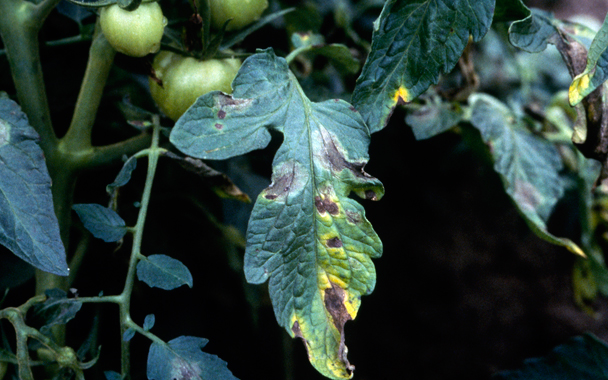How can something so right go so wrong? Just last week we were deliberating over how to stake our tomatoes, fawning over the little green fruit that had already appeared, and mounding up our potato plants. That was Before.
This week we’ve pulled all of our potatoes and a few of the tomato plants, harvesting what potatoes had, thankfully, already appeared (about 15 pounds of beautiful Russets and red Norlands) and disposing of the rest of the plant leaves (which had turned brown) and stems, placing them in a sealed garbage bag and putting them out with the trash.
Ladies and gentlemen, allow me to introduce you to late blight. It’s a fungal plague now being visited on many of our houses, a disease that affects tomatoes and potatoes, and, this time around, it began with plants from a commercial grower in the south and traveled to many of the big-box retailers’ garden departments, only to be dispersed far and wide, from Alabama to Maine. Supplier Bonnie Plants has instituted a plant recall in several states, losing as much as $1 million in the process.
Sure, you may have grown your tomatoes from seed, or bought your plants or potato seed stock from a reputable local producer. You might be safe. (You may be tired of hearing “buy local,” but in this instance it’s never been more sound advice). Yet since late blight is an airborne disease and spreads like wildfire, there’s a chance your crop will become infected anyway. And then, chances are, it will keep on traveling, to the farmer down the road who is not a part-time gardener but depends on that crop for her living. I hate to be the bearer of sad tidings, but the only sure way to eradicate blight is to destroy your plants. So get to know the signs of blight.
After the rains this season—which had many of us looking toward the horizon for the Space Needle, so assured were we that we’d been teleported to Seattle—you may think your plants are just suffering from being so wet for so long. Brown spots, curling leaves, and signs of white fungus, though, are classic symptoms of blight. Check out Cornell University’s updates, information, and photos from the Department of Plant Pathology, or take a sample of your plant to a Cooperative Extension office near you.
Stephen had already treated our tomato plants with copper spray, an organic fungicide. But when blight is in the house—it had already affected many of our neighbors’ plants—it’s hard to dodge the bullet. We’re grown-ups, and we’re accustomed to cutting our losses, but I’d be a liar if I said that tearing our plants out at the roots didn’t tear a little at our hearts. Our path back away from the garden became the Bridge of Sighs.
Back at home, I washed the dirt from the spuds we’d been able to save and baked one of the Russets, drizzling it with some olive oil and sprinkling it with a little salt and pepper. The next day I threw a few Norlands into a creamy horseradish potato salad. Maybe tomorrow I’ll tuck them into a samosa. So maybe it’s not going to be a bumper-crop year. But, putting the sighs on hold, it’s going to be the best potato-eating week of my life.

